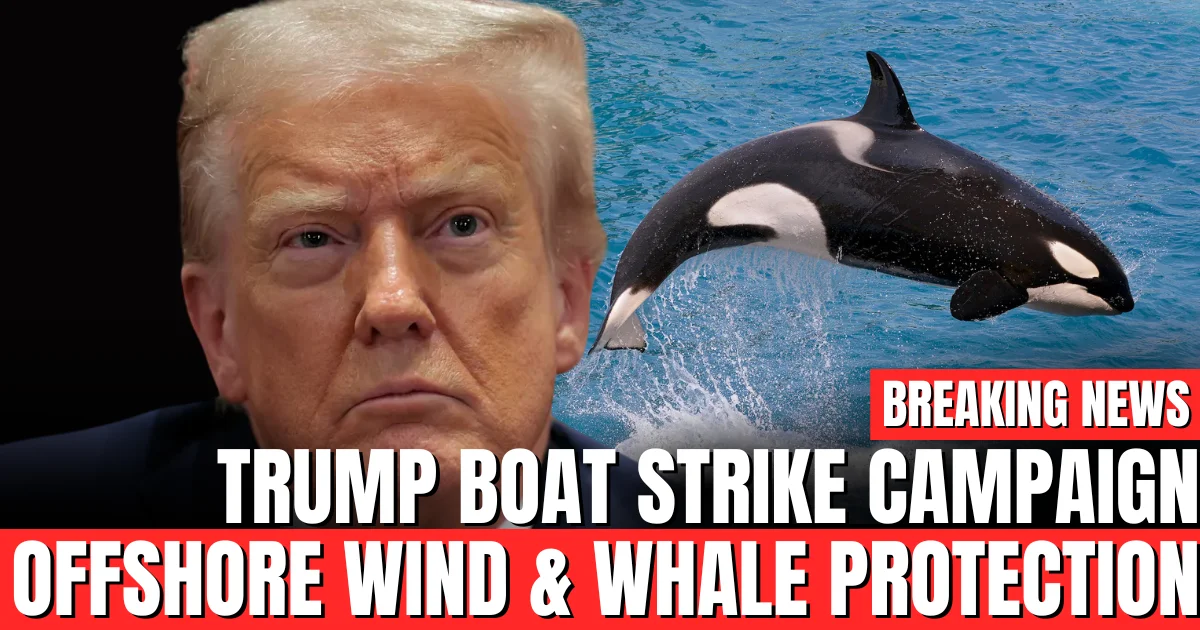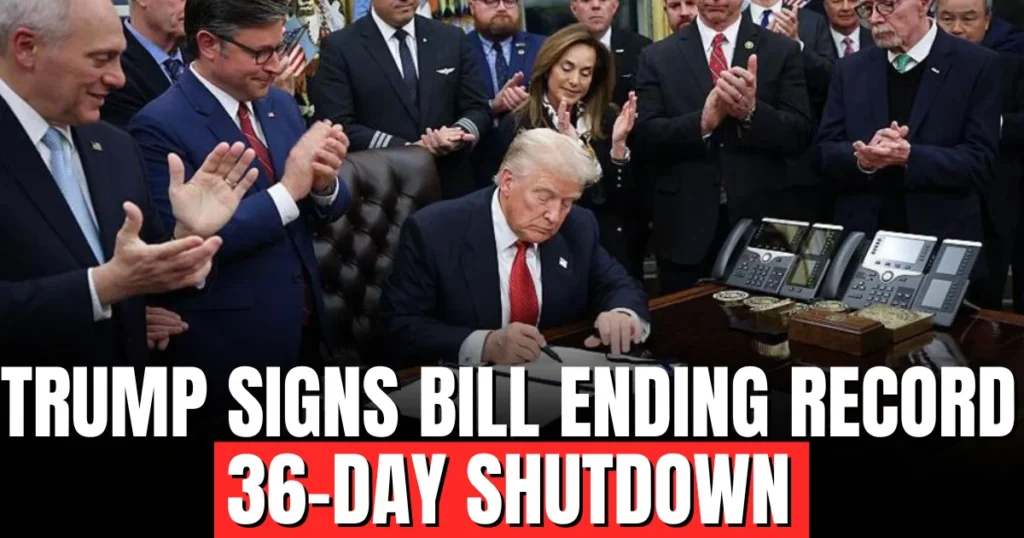What’s behind Trump’s boat strike campaign targeting offshore wind farms? Analysis of whale protection claims, political strategy, and energy policy implications.
Table of Contents
Trump’s Boat Strike Campaign: Political Strategy or Genuine Environmental Concern?
Former President Donald Trump has amplified focus on boat strikes and whale deaths, connecting them to offshore wind energy development in what critics call a strategic political campaign. His messaging targets renewable energy projects while claiming to champion marine mammal protection.
The campaign raises questions about motivations, scientific accuracy, and political strategy. Trump’s sudden environmental advocacy surprises observers given his administration’s environmental policy record.
Understanding the Boat Strike Argument
Trump’s campaign centers on claims that offshore wind farm construction increases whale deaths through boat strikes and acoustic disruption. He argues that vessel traffic associated with wind projects threatens marine mammals along the Atlantic coast.
Boat strikes occur when ships collide with whales, often causing serious injuries or death. These incidents represent legitimate conservation concerns affecting multiple whale species including endangered North Atlantic right whales.
Key campaign claims:
- Offshore wind construction vessels increase boat traffic dramatically
- Survey ships and turbine installation create dangerous conditions
- Sonar and construction noise disorient whales into shipping lanes
- Recent whale deaths correlate with wind farm development
- Renewable energy companies receive insufficient environmental scrutiny
Trump presents these arguments as environmental protection advocacy while simultaneously opposing wind energy projects he characterizes as unreliable and economically problematic.
Scientific Reality of Whale Deaths
Marine biologists and conservation organizations offer more complex explanations for whale mortality than Trump’s campaign suggests. Multiple factors contribute to marine mammal deaths along the eastern seaboard.
Documented causes of whale deaths:
Ship Strikes from Commercial Shipping
Large cargo vessels, tankers, and commercial shipping represent the primary boat strike threat to whales. These ships travel major shipping lanes at high speeds, giving whales little reaction time.
Fishing Gear Entanglement
Whales frequently become trapped in fishing equipment including nets, lines, and lobster pot ropes. Entanglement causes approximately equal mortality to ship strikes for some species.
Climate Change Effects
Warming ocean temperatures alter prey distribution, forcing whales into different areas including busy shipping channels. Changed migration patterns increase collision risks.
Noise Pollution
Commercial shipping, military sonar, and seismic testing create acoustic environments that can disorient marine mammals. Chronic noise pollution affects whale communication and navigation.
Ocean Pollution
Chemical contaminants, plastics, and other pollutants weaken whale health and immune systems. Compromised animals face higher mortality from various causes.
Scientific studies examining recent whale deaths along the Atlantic coast found no direct causal relationship with offshore wind development. National Marine Fisheries Service investigations attribute mortalities primarily to vessel strikes from commercial shipping and fishing gear entanglement.
Offshore Wind Industry Response
Renewable energy companies and industry associations strongly contest Trump’s characterization of wind farms as whale killers. They emphasize protective measures and regulatory requirements.
Industry safety measures:
Wind farm developers must comply with extensive marine mammal protection protocols during construction and operation. Federal permits require multiple safeguards.
Protected species observers monitor construction areas, halting work when whales appear nearby. Acoustic monitoring systems detect marine mammal presence.
Seasonal restrictions prevent construction during critical whale migration and calving periods. Speed restrictions apply to all project-related vessels in whale habitats.
Industry counterarguments:
The offshore wind sector notes that construction represents temporary activity while completed wind farms generate clean energy for decades without ongoing vessel traffic.
Some scientists suggest properly designed wind farms might actually reduce ship strikes by creating designated zones with controlled vessel traffic and speed limits.
Industry representatives accuse Trump of weaponizing environmental concerns to oppose renewable energy development for political and fossil fuel industry reasons.
Political Motivations Analysis
Political analysts examining Trump’s boat strike campaign identify multiple strategic objectives beyond genuine marine conservation.
Potential political goals:
Appealing to Coastal Voters
Offshore wind projects face local opposition in some coastal communities concerned about ocean views, fishing impacts, and property values. Trump’s campaign aligns with these voters’ interests.
Supporting Fossil Fuel Industry
Trump maintains strong ties to oil and gas sectors that view renewable energy as competitive threats. Opposing wind development serves these industry allies’ economic interests.
Differentiating from Democrats
Democratic administrations strongly support offshore wind development as climate change mitigation. Trump creates contrast by questioning renewable energy environmental benefits.
Simplifying Complex Issues
“Wind farms kill whales” provides emotionally resonant messaging easier to communicate than nuanced energy policy discussions. The narrative works effectively in brief media appearances.
Deflecting Climate Concerns
By framing himself as environmental protector opposing destructive wind energy, Trump counters criticism about climate change skepticism and environmental record.
Environmental Groups’ Perspectives
Established marine conservation organizations navigate complicated positions on this debate. Most support both whale protection and renewable energy development.
Conservation organization viewpoints:
Groups like Oceana and National Resources Defense Council acknowledge that offshore wind requires careful environmental management while noting that climate change represents the ultimate existential threat to marine ecosystems.
These organizations advocate for improved protective measures during wind farm construction while emphasizing that climate change caused by fossil fuel consumption threatens whales far more severely than renewable energy development.
Some environmental groups criticize both Trump’s selective concern and industry complacency. They push for stronger protections including expanded slow-speed zones, seasonal restrictions, and enhanced monitoring.
Balanced conservation approaches:
Leading marine scientists argue for evidence-based policies addressing documented threats proportionally. Since commercial shipping causes most boat strikes, vessel speed reductions in key areas would save more whales than stopping wind development.
Comprehensive strategies address multiple mortality factors including fishing gear modifications, shipping route adjustments, climate change mitigation, and careful renewable energy development with robust protections.
Economic and Energy Policy Context
The boat strike campaign occurs within broader energy policy debates affecting American economic and environmental futures.
Energy policy dimensions:
Renewable Energy Growth
Offshore wind represents significant investment and job creation along the Atlantic coast. Multiple states committed to purchasing wind energy to meet climate goals and diversify energy supplies.
Energy Independence
Domestic renewable energy reduces reliance on imported fossil fuels. This energy security argument traditionally appeals to conservative constituencies.
Economic Transitions
Moving from fossil fuels to renewables creates winners and losers economically. Oil and gas communities face job losses while renewable sectors expand employment.
Climate Change Economics
Long-term climate impacts including coastal flooding, extreme weather, and ecosystem disruption carry massive economic costs. Renewable energy development represents climate risk mitigation investment.
Trump’s campaign prioritizes immediate concerns and existing industry interests over long-term climate considerations and renewable energy transition benefits.
Regulatory and Legal Framework
Federal laws govern both offshore wind development and marine mammal protection, creating regulatory processes attempting to balance competing interests.
Key regulations:
Marine Mammal Protection Act
This federal law prohibits harming marine mammals and requires permits for activities that might affect protected species. Offshore wind projects undergo extensive review under these requirements.
Endangered Species Act
Additional protections apply to threatened species like North Atlantic right whales. Federal agencies must ensure projects don’t jeopardize species survival or critical habitats.
National Environmental Policy Act
Comprehensive environmental reviews assess offshore wind project impacts. Public comment periods allow stakeholder input before permits are granted.
These regulatory frameworks theoretically ensure adequate environmental protections while allowing carefully managed development. Debates continue about whether current processes provide sufficient safeguards.
What Coastal Communities Think
Public opinion in coastal areas directly affected by offshore wind development divides along multiple lines beyond simple partisan politics.
Some residents oppose visible turbines affecting ocean views and tourism aesthetics. Others welcome renewable energy and economic development opportunities.
Fishing communities express concerns about access to traditional grounds and potential impacts on fish populations. Commercial fishermen generally oppose offshore wind more strongly than recreational anglers.
Property owners debate whether wind farms decrease real estate values or provide long-term benefits through clean energy and economic development.
Community perspectives vary by:
- Proximity to proposed wind farms
- Economic dependence on ocean industries
- Environmental values and climate concerns
- Trust in regulatory processes
- Political affiliations and media consumption
Trump’s campaign resonates most strongly with communities already skeptical of offshore wind for various reasons. The whale argument provides additional justification for existing opposition.
Future Outlook
This campaign will likely intensify as offshore wind development accelerates and the 2025 election approaches. Expect continued debate about balancing renewable energy development with environmental protection.
Scientific research will continue examining offshore wind’s actual impacts on marine life. Long-term monitoring as projects become operational will provide clearer evidence about real effects versus speculative concerns.
Regulatory frameworks may evolve based on new evidence and political pressures. Enhanced protections could satisfy some concerns while allowing renewable energy development to proceed.
Political positioning on energy and environment will remain divisive, with offshore wind serving as a tangible issue crystallizing broader disagreements about climate policy and energy futures.
FAQ SECTION
1. What is Trump’s boat strike campaign about?
Trump’s campaign focuses on claims that offshore wind farm construction increases whale deaths through boat strikes and acoustic disruption. He argues that vessel traffic and construction noise associated with wind energy projects threaten marine mammals, particularly along the Atlantic coast. Critics suggest this represents political strategy to oppose renewable energy development rather than genuine environmental advocacy, given his administration’s environmental policy record.
2. Do offshore wind farms actually kill whales?
Scientific investigations by the National Marine Fisheries Service found no direct causal relationship between offshore wind development and recent whale deaths. Marine biologists attribute most whale mortality to commercial shipping vessel strikes, fishing gear entanglement, climate change effects, and ocean pollution. While offshore wind construction requires environmental management, documented evidence doesn’t support claims that wind farms represent primary threats to whale populations.
3. Why would Trump oppose renewable energy development?
Political analysts identify several potential motivations including appealing to coastal voters who oppose wind projects, supporting fossil fuel industry allies, creating policy contrast with Democratic climate initiatives, and countering criticism about his environmental record. The boat strike argument provides emotionally resonant messaging against renewable energy while positioning Trump as an environmental protector, despite his administration’s rollback of numerous environmental regulations.
4. What protections exist for whales during offshore wind construction?
Federal regulations require extensive marine mammal protections including protected species observers who halt construction when whales appear nearby, acoustic monitoring systems, seasonal restrictions during migration and calving periods, vessel speed limits in whale habitats, and comprehensive environmental reviews before permits are granted. The Marine Mammal Protection Act and Endangered Species Act provide legal frameworks ensuring offshore wind projects implement safeguards.
5. How do environmental groups view this debate?
Major marine conservation organizations support both whale protection and carefully managed renewable energy development. Groups like Oceana and NRDC acknowledge offshore wind requires environmental safeguards while emphasizing that climate change from fossil fuel consumption represents a far greater existential threat to marine ecosystems. They advocate for evidence-based policies addressing documented mortality causes proportionally, including commercial shipping speed reductions and fishing gear modifications.
CONCLUSION
Trump’s boat strike campaign weaponizes legitimate marine conservation concerns to oppose offshore wind development for what appears to be primarily political and economic motivations. While whale protection deserves serious attention, scientific evidence doesn’t support characterizing wind farms as primary threats to marine mammals.
The debate highlights tensions between renewable energy development and environmental protection, though these goals need not conflict when projects implement robust safeguards. Comprehensive approaches address actual documented threats including commercial shipping practices and fishing gear entanglement.
As offshore wind development accelerates and climate change intensifies, Americans face critical choices about energy futures. Productive discussions require honest assessment of tradeoffs, scientific evidence, and long-term consequences rather than selective environmental concern serving political agendas.
Do you think offshore wind farms threaten whales, or is this primarily political messaging? How should America balance renewable energy development with marine conservation? Share your perspective in the comments!

